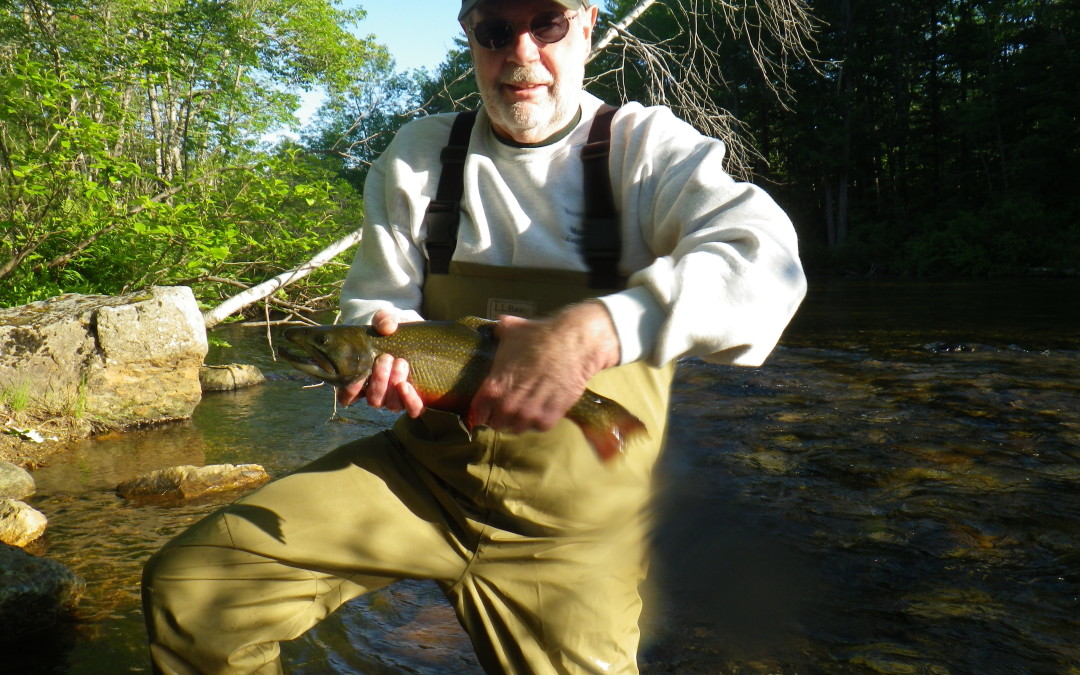The fishing this week has been very good throughout the Presumpscot River. Took a client out on Wednesday and the weather and the river conditions could not have been better. We were on the river by 6AM, which may be early for some, but that is the prime time to be on the water. We had the choice of any pool and it was not until 7:30AM when the next angler showed up. The other most important factor is that the trout and salmon are more active early and late in the day and will give any angler a better chance at hooking up with more fish. Within the first hour Bill had landed a nice brookie on a size 16 Hendrickson nymph fished right under the surface. We did not see the fish take, but we knew it was a good fish when Bill’s line pulled directly to the bottom of the pool. When we finally got eyes on it we knew it was a hefty brook trout. Luckily we landed the trout and after a few pictures we released it to be caught again by another lucky angler. We moved down the river to another pool that holds many fish. The main way to catch them there is through fishing nymphs deep and along the bottom. After a little instruction on fishing with this technique Bill hooked one trout that he lost and then landed another. Not bad for someone who had never fished in this manner. After a good morning it was refreshing to take a break and cook a nice shore side lunch. Steak strips with herbed butter rice along with fiddleheads cooked in salt pork hit the spot and then we were ready to fish the rest of the day. If you have never had fiddleheads they are a Maine specialty and a must during the spring time after they are freshly picked. The rest of the day was not as eventful as the morning, but we ended our day by watching a nice brook trout actively feeding in a pool. We were not more than 5 feet from the trout and we watched as this trout would sway side to side taking insects. One can learn so much just from watching their habits and how they move in the water to feed.
On Thursday I explored a different stretch of the Presumpscot River below Dundee dam. When I got to the river the brown trout were rising throughout and I could see even more hanging along the bottom. This section near the dam has many conflicting currents which makes it difficult to present your fly without any drag. Blue Winged Olive patterns were the ticket today and many trout were taken with multiple patterns. With the structure of the river here there is the distinct possibility of some very large hold over fish taking refuge along the deep cut banks. With brown trout the best time to target these larger trout would be in the evening when they leave their shelter to feed. After a few hours on this stretch I relocated to the upper section of the river where very small nymphs were deadly. A size 18 Barr Emerger in the Blue Winged Olive color took many fish on the swing above the bridge. One of the best things about this section is the water clarity. While standing in the river you can see fish moving from pool to pool or holding and feeding on drifting insects. Many times trout will swim right by you and a good pair of polarized sunglasses allow you to see everything.
Trout have been very receptive to surface offerings, but make sure that you try to match the hatch to be more successful. Saturday night there was a black caddis hatch along with an Isonychia hatch. These types of multiple hatches can be difficult as the trout could be focused on one hatch over the other and could be taking emerging nymphs under the surface without any signs. Make sure that you pay attention to how the fish are rising. If there are splashy rises then they are taking emerging nymphs. If there are dimples then they are taking the adult flies. If you do not see anything on the surface when there is an abundant hatch try to fish nymphs deep and swing them at the end of your drift to imitate any hatching nymph. The trout this night were taking Isonychia nymphs right under the surface and the size of these trout were clearly evident as they would porpoise out of the water. When they do this they show their whole dorsal fin and tail fin, which makes it easy to identify the species of trout. In this pool there are brown and brook trout. I had hooked and landed a few trout in the lower part of the pool on a caddis pattern. As the sun went down and the sky turned dark the larger trout began rising at the head of the pool. After a few misses on a dry fly I switched to a small prince nymph and quickly hooked into a nice brook trout. Shortly after releasing that trout the rest of the fish in the pool stopped rising and it became too dark to even see in front of me. Not a bad way to spend a Saturday night.







